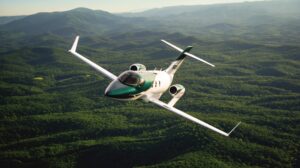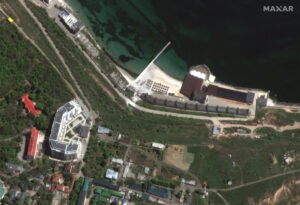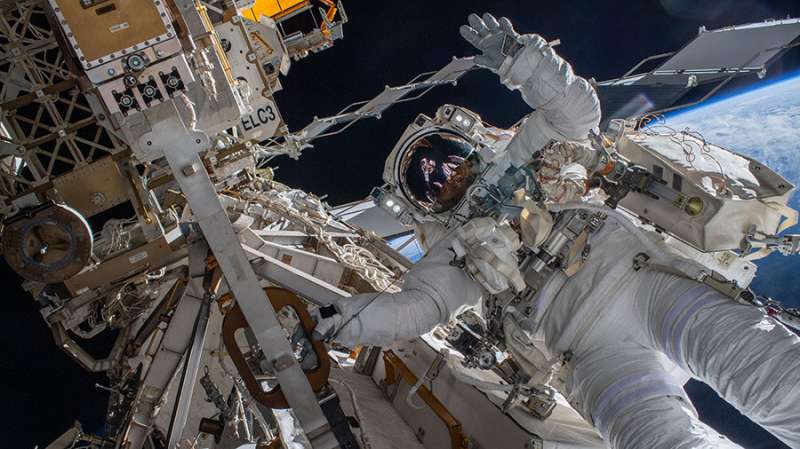Gogo’s OneWeb partnership could face Starlink in business aviation market
Wednesday, 25 May 2022 20:28
Gogo is planning to use OneWeb satellites in a partnership that could see it take on Starlink in an emerging business aviation market for low Earth orbit services.
The post Gogo’s OneWeb partnership could face Starlink in business aviation market appeared first on SpaceNews.
Virgin Orbit expects first U.K. launch in August
Wednesday, 25 May 2022 20:13
Virgin Orbit expects to perform its first launch from England in late August, pending award of a British launch license, a company executive said May 25.
The post Virgin Orbit expects first U.K.
BlackSky, Maxar, Planet win 10-year NRO contracts for satellite imagery
Wednesday, 25 May 2022 16:02
The National Reconnaissance Office announced May 25 it awarded BlackSky, Maxar Technologies and Planet Labs 10-year contracts to provide satellite imagery for U.S. intelligence, defense and federal civil agencies.
The post BlackSky, Maxar, Planet win 10-year NRO contracts for satellite imagery appeared first on SpaceNews.
Industry looks to decentralized approaches to space sustainability
Wednesday, 25 May 2022 15:17
As governments make slow progress on space traffic management systems, companies may be able work together more quickly to develop processes to support space sustainability.
The post Industry looks to decentralized approaches to space sustainability appeared first on SpaceNews.
Spacesuits are leaking water and NASA is holding off any spacewalks until they can solve the problem
Wednesday, 25 May 2022 13:31
NASA's spacesuits are getting old. The extra-vehicular mobility units—EMUs for short—were designed and built for spacewalks outside NASA's space shuttles, which flew for the last time in 2011. Nowadays, the EMUs are an integral part of maintaining and upgrading the International Space Station (ISS) exterior, providing the crew with the ability to live and work in the vacuum of space for extended periods of time (spacewalks regularly last from 6 to 8 hours). However, at the end of the most recent spacewalk on March 23, NASA astronaut Kayla Barron discovered water in the helmet of German astronaut Matthias Maurer while she helped him remove the suit.
Historic Greenland ice sheet rainfall unravelled
Wednesday, 25 May 2022 12:30
For the first time ever recorded, in the late summer of 2021, rain fell on the high central region of the Greenland ice sheet. This extraordinary event was followed by the surface snow and ice melting rapidly. Researchers now understand exactly what went on in those fateful summer days and what we can learn from it.
From Rome to Bonn by bike
Wednesday, 25 May 2022 10:55 Image:
Omar Di Felice, an extreme cyclist, has biked from Rome to Bonn to take part at ESA’s Living Planet Symposium. Tune in today at 15:30 live from Bonn on ESA Earth Observation Instagram as he’s joined by ESA Astronaut Luca Parmitano and ESA CryoSat Mission Geophysicist Alessandro di Bella.
Image:
Omar Di Felice, an extreme cyclist, has biked from Rome to Bonn to take part at ESA’s Living Planet Symposium. Tune in today at 15:30 live from Bonn on ESA Earth Observation Instagram as he’s joined by ESA Astronaut Luca Parmitano and ESA CryoSat Mission Geophysicist Alessandro di Bella. Boeing's Starliner faces one more challenge as it returns to Earth
Wednesday, 25 May 2022 10:44 Boeing's Starliner capsule is readying to return to Earth on Wednesday in the final step of a key test flight to prove itself worthy of providing rides for NASA astronauts to the International Space Station.
The spaceship is scheduled to autonomously undock at 2:36 pm Eastern Time (1836 GMT) and touch down in New Mexico just over four hours later, at 2249 GMT, wrapping up a six-day mission c
Boeing's Starliner capsule is readying to return to Earth on Wednesday in the final step of a key test flight to prove itself worthy of providing rides for NASA astronauts to the International Space Station.
The spaceship is scheduled to autonomously undock at 2:36 pm Eastern Time (1836 GMT) and touch down in New Mexico just over four hours later, at 2249 GMT, wrapping up a six-day mission c InSight's Final Selfie
Wednesday, 25 May 2022 10:44 NASA's InSight Mars lander took this final selfie on April 24, 2022, the 1,211th Martian day, or sol, of the mission. The lander is covered with far more dust than it was in its first selfie, taken in December 2018, not long after landing - or in its second selfie, composed of images taken in March and April 2019.
The arm needs to move several times in order to capture a full selfie. Becau
NASA's InSight Mars lander took this final selfie on April 24, 2022, the 1,211th Martian day, or sol, of the mission. The lander is covered with far more dust than it was in its first selfie, taken in December 2018, not long after landing - or in its second selfie, composed of images taken in March and April 2019.
The arm needs to move several times in order to capture a full selfie. Becau NASA-supported solar sail could take science to new heights
Wednesday, 25 May 2022 10:44 As NASA's exploration continues to push boundaries, a new solar sail concept selected by the agency for development toward a demonstration mission could carry science to new destinations.
The Diffractive Solar Sailing project was selected for Phase III study under the NASA Innovative Advanced Concepts (NIAC) program. Phase III aims to strategically transition NIAC concepts with the highest
As NASA's exploration continues to push boundaries, a new solar sail concept selected by the agency for development toward a demonstration mission could carry science to new destinations.
The Diffractive Solar Sailing project was selected for Phase III study under the NASA Innovative Advanced Concepts (NIAC) program. Phase III aims to strategically transition NIAC concepts with the highest Soil, sutures, and climate modeling among investigations riding SpaceX CRS-25 Dragon to ISS
Wednesday, 25 May 2022 10:44 The 25th SpaceX cargo resupply services mission (SpaceX CRS-25) carrying scientific research and technology demonstrations to the International Space Station is scheduled for launch June 7 from NASA's Kennedy Space Center in Florida. Experiments aboard the Dragon capsule include studies of the immune system, wound healing, soil communities, and cell-free biomarkers, along with mapping the compos
The 25th SpaceX cargo resupply services mission (SpaceX CRS-25) carrying scientific research and technology demonstrations to the International Space Station is scheduled for launch June 7 from NASA's Kennedy Space Center in Florida. Experiments aboard the Dragon capsule include studies of the immune system, wound healing, soil communities, and cell-free biomarkers, along with mapping the compos OneWeb and TinSky complete first West African LEO Satellite Gateway
Wednesday, 25 May 2022 10:44 TinSky Connect has successfully completed the installation of 15 OneWeb antennas and customer provided equipment at a Satellite Network Portal (SNP) or gateway facility in Accra, Ghana.
OneWeb is a global communications network powered through space, enabling connectivity for governments, businesses, and communities. Tinsky Connect was selected as OneWeb's technical engineering partner for
TinSky Connect has successfully completed the installation of 15 OneWeb antennas and customer provided equipment at a Satellite Network Portal (SNP) or gateway facility in Accra, Ghana.
OneWeb is a global communications network powered through space, enabling connectivity for governments, businesses, and communities. Tinsky Connect was selected as OneWeb's technical engineering partner for CubeSat set to demonstrate NASA's fastest laser link from space
Wednesday, 25 May 2022 10:44 NASA's Pathfinder Technology Demonstrator 3 (PTD-3) mission, carrying the TeraByte InfraRed Delivery (TBIRD) system, will debut on May 25 as part of SpaceX's Transporter-5 rideshare launch. TBIRD will showcase the high-data-rate capabilities of laser communications from a CubeSat in low-Earth orbit. At 200 gigabits per second (Gbps), TBIRD will downlink data at the highest optical rate ever achi
NASA's Pathfinder Technology Demonstrator 3 (PTD-3) mission, carrying the TeraByte InfraRed Delivery (TBIRD) system, will debut on May 25 as part of SpaceX's Transporter-5 rideshare launch. TBIRD will showcase the high-data-rate capabilities of laser communications from a CubeSat in low-Earth orbit. At 200 gigabits per second (Gbps), TBIRD will downlink data at the highest optical rate ever achi Varda Space Industries orders 4th Photon from Rocket Lab for In-Space Manufacturing
Wednesday, 25 May 2022 10:44 Rocket Lab (Nasdaq: RKLB) and Varda Space Industries, the world's first In-space manufacturing and hypersonic Earth re-entry logistics company, report that Varda will procure a fourth Photon spacecraft. The deal follows on a previous bulk-order by Varda in August 2021 for three Photon spacecraft from Rocket Lab.
The Rocket Lab-designed and built Photon spacecraft will provide power, commun
Rocket Lab (Nasdaq: RKLB) and Varda Space Industries, the world's first In-space manufacturing and hypersonic Earth re-entry logistics company, report that Varda will procure a fourth Photon spacecraft. The deal follows on a previous bulk-order by Varda in August 2021 for three Photon spacecraft from Rocket Lab.
The Rocket Lab-designed and built Photon spacecraft will provide power, commun Polar Ice and Snow monitoring mission CRISTAL on track
Wednesday, 25 May 2022 10:44 The Copernicus Polar Ice and Snow Topography Altimetry mission CRISTAL is clearly on track. Following an intensive review process the European Space Agency ESA has confirmed that the preliminary design of the satellite meets all system requirements.
CRISTAL will carry an advanced multi-frequency altimeter that will measure sea ice thickness and ice sheet elevations - key climate change ind
The Copernicus Polar Ice and Snow Topography Altimetry mission CRISTAL is clearly on track. Following an intensive review process the European Space Agency ESA has confirmed that the preliminary design of the satellite meets all system requirements.
CRISTAL will carry an advanced multi-frequency altimeter that will measure sea ice thickness and ice sheet elevations - key climate change ind 
